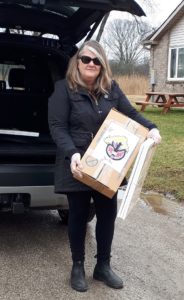Sarnia area artist shares art kits to help youth, children, parents during pandemic

By Colin Graf
AAMJIWNAANG FIRST NATION— An artist from the Ipperwash area is sharing art kits to help youth, children, and parents remaining indoors during the coronavirus disease 2019 (COVID-19) pandemic. After her series of workshops on intuitive spirit painting were cancelled in locations nearby such as Chippewas of Kettle & Stony Point (KSP) First Nation, Suellen Evoy-Oozeer decided to reach out to her students and distribute the art kits she had been storing for those events.
“I want to give them something to do and some way to connect with each other,” she said, so Evoy-Oozeer decided to offer to drop off the kits where they were wanted and to open up a Facebook page, “Me, You, & Us Youth”.
KSP youth were supposed to exhibit their art in the town of Port Franks, on Lake Huron, in May, but that exhibit has been moved to September. She hopes Aamjiwnaang youth may still be able to exhibit their work during the annual First Nations art show at the Lawrence House gallery in Sarnia in June if circumstances allow.
Evoy-Oozeer has now offered the 30 kits in her garage to anyone who wants them from the two First Nations, though she may not be able to deliver to KSP because of restrictions placed on visiting the community.
She is observing protocols for sanitation and distancing in the delivery of the kits. The art supplies have been in her garage for over a month, so she feels there is no chance of infection. She wears gloves for the deliveries and maintains no contact with the people receiving the kits.
“I will drop them off on their doorstep, go back to my car and text them,” the artist says.
The kits include paints, brushes, a large canvas, a 9 x 12 sketch pad and some drawing tools, either pencils or a fine-tipped pen.
“It’s not a lot but it’s enough to keep them busy for a bit,” she says.
She’s also including a copy of the book from the 2019 exhibition she helped create in the Kettle Point area called, Me, You, and Us, which includes ideas for creating what Evoy-Oozeer calls “spirit portraits” showing different aspects of the artists’ inner lives. So far, she has delivered kits to 10 different families.
Samantha Jacobs of Aamjiwnaang got one of those kits and finds creating art is helping her stay focussed, pass the time and keeps her mind busy during isolation. She had completed two out of three sessions Evoy-Oozeer was conducting at the community centre prior to the abrupt closure. Jacobs had hoped to complete a papier-mâché artwork that would resemble herself, but would open up to reveal aspects of herself. She had the newspaper and the glue ready but was unable to go ahead. Now she is using the paints and chalk pastels in the kit a couple of hours every night. Her favourite so far is one with a younger and an older turtle swimming. Jacobs is the young turtle while the older turtle represents her uncle Errnol Gray, or “Uncle Turtle” as she called him before he passed in 2018. Gray was an Aamjiwnaang councillor for 42 years, and Jacobs remembers him fondly.
Evoy-Oozeer’s original Me, You, and Us project featured 27 spirit portraits she painted of KSP members. The exhibition was first shown at a London, Ont. gallery, followed by a two-week stay at the Lambton Heritage Museum, between KSP and the town of Grand Bend, with further stops in Windsor and the Ottawa area.
The portraits were part of a wider effort to connect the First Nations people with the settler community in Lambton County, along the south shore of Lake Huron. Evoy-Oozeer and her friend Susan Angela Bressette held workshops for people from both communities to learn intuitive painting techniques and get to know each other.
The workshops last year were a catalyst for understanding and change in the relationship between the First Nation and surrounding community, Bressette told Anishinabek News at the time.
“If you could see the healing that came from our little art class. There’s something that came from our classes that one friend said I should just call magic,” she recalled. “We don’t have an explanation for what happened there, but a lot of people found the freedom to talk about things in their lives like residential schools.”
Art created by the workshop participants also made up part of the 2019 exhibit.


